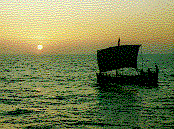

IT WAS A MERCHANT VESSEL
This (the Kyrenia ship) is a typical medium-size vessel that was in operation in the empire of Alexander the Great and his successors. It was a merchant ship which would carry any type of cargo that it could take. We believe it followed a route that started every year when the winds from the North were favourable, sailing towards the islands of the Eastern Aegean or along the lonian coast before coming down as far as Cyprus and most probably Syria. The following year, when the winds helped the ship to sail off, it would set out for the same islands. Ships did not sail in winter: the Mediterranean Sea was "closed" from November to March*.
The captain used to be both the owner and trader on the ship, carrying his money with him and following any route he deemed necessary.
Seamen then did not have any of the instruments of navigation that we have today. At night - and this happened only when it was absolutely necessary - they used to travel guided by the stars on their course. Normally they followed the coastline, looking for signs on the horizon and surveying the islands. You see, the Aegean is an area which looks as though it were made for navigation because you can see an island or a shore afany time. The protractor had, of course, been invented but I don't think it was used on ships. There was also the astrolabe, a specimen of which was found on a ship of a later date, but this does not seem to have been in common use for navigation.
People used to travel empirically and had to cope with a lot of problems, especially in the open sea. One knew when he would depart but didn't know when or how he would arrive. We have a description of a ship of
the Hellenistic period which set sail from Alexandria to go to Rome and found itself in Rhodes and then in Piraeus and it was months before it finally reached its destination. Another Greek seaman who lived in the óth century B.C set off for Africa and found himself in Gibraltar. The wind was all-powerful and took them where it pleased.
Extract from an interview with HARIS TZALAS, HIPNT Chairman, for CyBC's broadcast "Radioscope".
Interviewer GEORGE NICOLAOU.
The experimental sailing expeditions of KYRENIA II revealed that probably ships did sail in winter time.